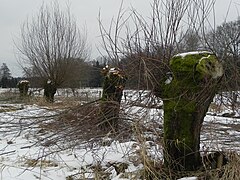Snowing
Schneitelung (in Upper German also spelled Schnaitelung , also Schnaiteln , Schneiteln , Schnarteln ) is the pruning of trees (e.g. ash , willow ) in the Schneitelwirtschaft to obtain the shoots or leaves as animal feed ( leaf hay as roughage ) and litter . At the same time, the shading of the adjacent areas is reduced. The cut off shoots or leaves have been used as food since the Neolithic Age . There are four types of leaf fodder production:
- Branch cutting - leafy branches are cut off for deciduous hay, firewood or wattle wood
- Schneitelung - pruning the trees at about chest height prevents grazing cattle or game from biting the young rash ; there arise z. B. Linden and pollarded willows
- Falling leaves - only the leaves are plucked from the branches and dried as winter fodder; The foliage of ash and hornbeam was used in particular
- Stock pollarding - the trees are on stock set , d. H. cleared down to the rootstock ; the following rash forms the coppice
In the case of willows , the upper part of the tree is cut off at a height of typically 1–2 meters (head clipping). In horticulture it has to say and decapitation . There new shoots are formed that can be used for various purposes. From willow shoots you can z. B. Manufacture basketry . The tree grows in the shape of a pollarded willow tree . Stronger shoots have to be cut or removed regularly (usually over several years if they become lignified) so that the damaged tree does not break under its own weight and continues to form young shoots.
In some trees, the young shoots and leaves are suitable as fodder. For this purpose, the common ash ( Fraxinus excelsior ) was mainly cultivated in the Alpine region until the early 20th century . The shoots were cut with a practice . This form of management is called Schneitelwirtschaft .
history
The Schneitelwirtschaft emerged in Central Europe among the ribbon ceramists in the Neolithic .
Until the 18th century, the Schneitelwirtschaft was practiced in all deciduous forests in Europe. Today it is only practiced in remote areas of Southeast Europe ( Carpathians and Balkan Mountains ) and the Pyrenees , as well as in parts of Africa, in South Asia (India, Pakistan, Nepal) and, for example, Bolivia.
With the retreat of people, especially from the southern Alpine region and the Apennines, at the beginning and middle of the 20th century, the Schneitel economy also almost came to a standstill and the former Schneitel stocks in the form of hedges and sparse forests are predominantly reforested.
Pollard willows in the Britzer Garten , Berlin, March 2018
literature
- Richard B. Hilf: The forest. Forests and pastures in the past and present . Part 1, reprint . Aula, Wiebelsheim 2003, ISBN 3-494-01331-4 .
- Hans Hausrath : History of German silviculture. From its beginnings to 1850 . Series of publications by the Institute for Forest Policy and Regional Planning at the University of Freiburg. Hochschulverlag, Freiburg im Breisgau 1982, ISBN 3-8107-6803-0 .
- P. Rasmussen: Leaf-Foddering of Livestock in the Neolithic. Archaeobotanical Evidence from Weier, Switzerland. In: Journal of Danish Archeology 1989 (8), pp. 51-71.
Movie
- Habitat head tree. The sustainable benefits of pruning. (OT: Trognes, les arbres aux mille visages. ) Documentary film, France, 2017, 51:35 min., Script and direction: Timothée Janssen, production: Camera Lucida Productions, arte France, first broadcast: June 8, 2018 by arte, summary from ARD , online video.
Web links
Footnotes
- ↑ http://www.siebenfahr.com/Bauernjahr.pdf
- ↑ a b c d Keyword Schneitelwirtschaft , In: www.Agrarraum.info; accessed in March 2019.


